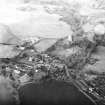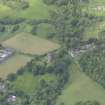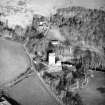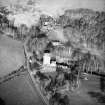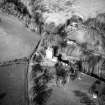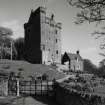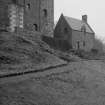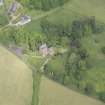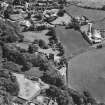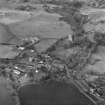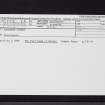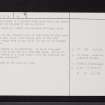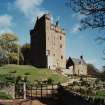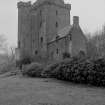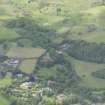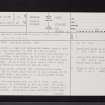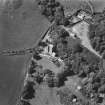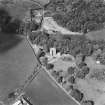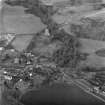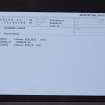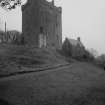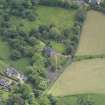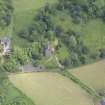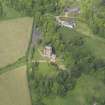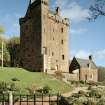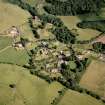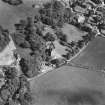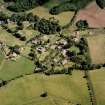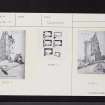Kinnaird Castle
Tower House (Medieval)
Site Name Kinnaird Castle
Classification Tower House (Medieval)
Canmore ID 30436
Site Number NO22NW 24
NGR NO 24122 28904
Datum OSGB36 - NGR
Permalink http://canmore.org.uk/site/30436
- Council Perth And Kinross
- Parish Kinnaird
- Former Region Tayside
- Former District Perth And Kinross
- Former County Perthshire
NO22NW 24 24122 28904
(NO 2412 2890) Kinnaird Castle (NR)
OS 6" map (1970)
Kinnaird Castle, a tall and impressive tower, once a roofless ruin, was restored in 1855 (SDD List 1966) and is again inhabited. Tranter considers it to be of 15th century, or possibly earlier, date, while the SDD date it to about 1500 and MacGibbon and Ross state it dates from the early 16th century. It is oblong on plan with a small projecting tower or buttress at the SW angle.
The building, which formerly had a courtyard or outer bailey to the W, rises four storeys to the parapet, 60ft above ground level, and there is a gabled garret storey above, within the parapet walk.
There are two entrances, both in the S front. One, at basement level, is protected by an iron yett; the other, at first floor in the buttress tower, is now reached by a stone forestair. Originally almost certainly this door would give access to a parapet walk which would run round the top of the walling of the courtyard. E of the tower is a small two-storeyed building, dated 1610.
Kinnaird was the original seat of the family of that name, who it is said built their castle here in the 13th century, though this is too early for any of the present buildings.
D MacGibbon and T Ross 1887; N Tranter 1963.
Photographed by the RCAHMS in 1980.
(Undated) information in NMRS.
NMRS REFERENCE
Architect: Dr. Peter McGregor Chalmers 1888 (presumably restoration of Kinnaird Castle)
Antiquarian Observation (1857 - 1861)
Mason's marks from Scottish churches, abbeys and castles recorded between 1857 and 1861 on 29 drawings in the Society of Antiquaries of Scotland Collection.
Field Visit (11 June 1964)
Kinnaird Castle is as described. It is in very good condition and is in use as a dwelling house. On its W side are traces of a stony mound which may indicate the wall of the courtyard (Mr Stout, occupier, Kinnaird Castle). Visited by OS (WDJ) 11 June 1964.
Field Visit (June 1989)
Kinnaird Castle is a restored tower-house of the late 15th or early 16th century, which occupies a prominent rock outcrop on the Braes of Gowrie, overlooking the Carse. It consists of a well-appointed main block, four storeys and a garret in height (11.8m from E to W by 8.36m transversely over walls up to 2.15m thick at first-floor level), with a buttress at the SW angle which is carried up to the height of the main wall-head.
An entrance at first-floor level may have given access to the wall-walk of a barmkin, whose position enclosing the W side of the tower is indicated by the presence of a cut-back section of wall and tuskers at the NW angle of the main block, and the character of the buttress (both of which are 2m thick); the purpose of tusking at the NE angle of the main block is less clear. A mid 19th-century sketch of the tower (NMRS PT/13931), made prior to the restoration, shows it without a garret, but with a corbel course at the height of the main wall-head, together with projecting corbels, possibly for a machicolation, oversailing the main entrance.
To the E of the tower there is a gabled kitchen block (the fireplace was removed about 1955). It incorporated a number of dressed stones and a half dormer with a pediment bearing the initials PT/11/MO and the date 1610; the block has been remodelled more than once.
In the reign of William I (1165-1214) Kinnaird belonged to the family of that ilk; in 1674 it passed to the Threiplands, later of Fingask.
Visited by RCAHMS (IMS/PC) June 1989.
OSA 1793; NSA 1845; D MacGibbon and T Ross 1887-92; L Melville 1939; Reg Reg Scot 1971.














































